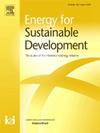Empowering sustainable design decisions: A multicriteria metric for optimizing solar protection systems
IF 4.9
2区 工程技术
Q2 ENERGY & FUELS
引用次数: 0
Abstract
The accelerated growth of urban areas has significantly increased global energy consumption and greenhouse gas emissions, highlighting the urgency of integrating sustainable strategies into architectural design. This study proposes a methodological framework to support decision-making during the early design stages through parametric simulations and multi-objective optimization. The objective is to improve energy performance by analyzing the geometric characteristics of solar shading systems in a form of external venetian blinds across multiple design scenarios.
A statistical correlation analysis was carried out to identify the design parameters with the greatest influence on energy performance. The results indicate that the depth of the shading device and the number of louvers consistently correlate with both cooling energy demand and daylight availability, regardless of climate. These correlations align with the geometric patterns observed in the optimized solutions, underscoring the value of data-driven approaches in developing climate-responsive strategies.
The NSGA-II algorithm was used to optimize two conflicting objectives: minimizing cooling energy demand and maximizing daylight quality. The resulting Pareto front provided a diverse set of non-dominated solutions, allowing for the exploration of performance trade-offs. To enhance interpretability, K-Means clustering was applied to group optimal configurations.
The methodology was tested in two variant ASHRAE climate zones—5B (cool-dry, Mendoza, Argentina) and 5A (cool-humid, Łódź, Poland)—achieving cooling demand reductions of 39.8 % and 33.5 %, respectively, with proportional decreases in CO₂ emissions linked to the carbon intensity of the local grids, while maintaining strong performance in Useful Daylight Illuminance (UDI). As its main contribution, this study introduces the Shading Multicriteria Metric (SMM), which integrates thermal, daylight, and environmental indicators into a single adaptable metric. Beyond case-specific results, the framework demonstrates its value as a replicable methodological approach, capable of guiding early-stage design decisions toward geometrically diverse, climate-responsive, and energy-efficient solutions that align with long-term sustainability goals.
授权可持续设计决策:优化太阳能保护系统的多标准度量
城市地区的加速增长显著增加了全球能源消耗和温室气体排放,凸显了将可持续战略融入建筑设计的紧迫性。本研究提出了一个方法框架,通过参数模拟和多目标优化来支持早期设计阶段的决策。目的是通过分析在多种设计方案中采用外部百叶百叶窗形式的遮阳系统的几何特征来提高能源性能。通过统计相关分析,找出对能源性能影响最大的设计参数。结果表明,遮阳装置的深度和百叶的数量始终与冷却能源需求和日光可用性相关,而与气候无关。这些相关性与优化解决方案中观察到的几何模式一致,强调了数据驱动方法在制定气候响应战略方面的价值。NSGA-II算法用于优化两个相互冲突的目标:最小化冷却能源需求和最大化日光质量。由此产生的Pareto前沿提供了一组不同的非主导解决方案,允许探索性能权衡。为了提高可解释性,将k均值聚类应用于分组最优配置。该方法在两个不同的ASHRAE气候区- 5b(阿根廷门多萨的冷干气候区)和5A(波兰Łódź的冷湿气候区)进行了测试,分别实现了39.8%和33.5%的制冷需求减少,与当地电网的碳强度相关的CO₂排放量按比例减少,同时保持了良好的有用日照度(UDI)性能。作为其主要贡献,本研究引入了遮阳多标准度量(SMM),它将热、日光和环境指标集成到一个单一的适应性度量中。除了具体案例的结果,该框架还展示了其作为一种可复制的方法方法的价值,能够指导早期设计决策朝着几何多样化、气候响应和节能的解决方案发展,并与长期可持续发展目标保持一致。
本文章由计算机程序翻译,如有差异,请以英文原文为准。
求助全文
约1分钟内获得全文
求助全文
来源期刊

Energy for Sustainable Development
ENERGY & FUELS-ENERGY & FUELS
CiteScore
8.10
自引率
9.10%
发文量
187
审稿时长
6-12 weeks
期刊介绍:
Published on behalf of the International Energy Initiative, Energy for Sustainable Development is the journal for decision makers, managers, consultants, policy makers, planners and researchers in both government and non-government organizations. It publishes original research and reviews about energy in developing countries, sustainable development, energy resources, technologies, policies and interactions.
 求助内容:
求助内容: 应助结果提醒方式:
应助结果提醒方式:


